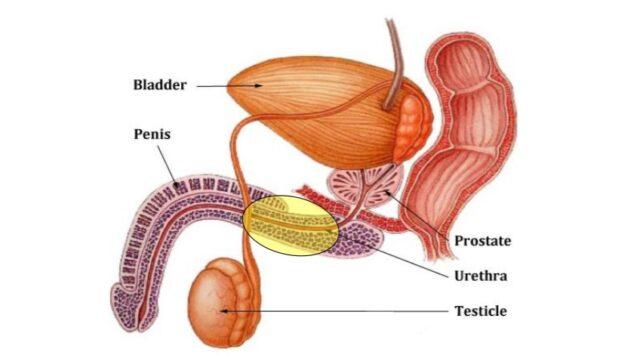What is Urethral Stricture?
It is an anatomical narrowing along the length of urethra which can involve various parts of urethra extending from membranous urethra to penile urethra. Narrowing of prostatic part is not termed as urethral stricture, its pathophysiology is different.

Symptoms of Urethral Stricture
Symptoms can range among the following:
- Straining during micturition
- Thin stream of urine or a stream that stops and starts
- Urinary hesitancy
- Not able to urinate
- Urine infection
- Blood in urine.
- Not able to catheterise urethra
- Urethral abscess
- Renal failure
- Urinary Incontinence – leaking urine in pants.
Causes of Urethral Stricture
There are many factors which can give rise to urethral stricture:
- Inflammatory (20%) – These occur as a result of prior infection/inflammation involving the urethra
- Iatrogenic (32%) – These strictures occur as a result of instrumentation, after TURP, prolonged catheterization, hypospadias repair, etc
- Traumatic (14%) – Most occur due to pelvic fractures or due to straddle injury. Mostly are short and bulbar in location
- Idiopathic (34%) – In some patients, no cause can be found, these can be due to some unrecognized childhood trauma
What are the treatment options available?
Based on the location and length of urethral stricture, various options are available for its management.
In short segment strictures 1-2 cm in length, optical internal urethrotomy can be done. In long segment urethral strictures, substitution urethroplasty using buccal mucosa is advised.
Pre-operative planning done before the surgery
- You will need to undergo few tests before the surgery, some are disease specific and some are anaesthesia specific, these include few blood tests, urine tests, chest X ray, ECG, and other tests as prescribed by anaesthetist for pre-operative fitness.
- You should always tell the doctor about all medicines you are taking before the procedure, allergy to any food/ medicines.
- You will need to get admitted one day before the surgery or on day of surgery as decided by doctor. You will be asked to remain completely empty stomach 6 hours before the surgery (Even water, tea, coffee or biscuits are not allowed).
- You will be asked to sign a consent form before the surgery after understanding in detail all the risks and benefits involved with the procedure.
- Avoid blood thinners (Aspirin/clopidogrel/etc) for at least one week prior to procedure (if you have been prescribed such medicines please discuss with your doctor on when you should stop them before the surgery and when to resume them after the surgery).
- Patient is advised to start cleaning genitalia and perineal area with soap and water every day till day of surgery.
- Patient is asked to do chlorhexidine mouth wash daily till day of surgery.
- Patient is advised to quit tobacco intake in any form as it adversely affects the quality of buccal mucosa.
- Part preparation of beard, moustache and genitalia would be done by staff before the surgery.
- You will be administered pre-operative intravenous antibiotic half hour before the surgery.
Details of the procedure
- On day of surgery, after detailed informed consent from the patient and relatives, patient will be shifted to operation theatre room.
- This procedure can be done under spinal/ general anaesthesia. If done under spinal anaesthesia, buccal mucosa is grafted under local anaesthesia.
- A vertical cut is made on the perineum (between the back of your scrotum and anus), deepened, and urethral is separated from surrounding structures.
- The urethra is opened along the strictured area, scar tissue is excised and the buccal mucosa graft (inner lining of the mouth) is placed on the healthy urethral edges.
- The inner side of cheek from where the graft is taken, heals very rapidly within 24-48 hours, it may or may not be stitched.
- A drain may be placed adjacent to the incision, and a Foley catheter is placed over which the urethroplasty is done for 2-3 weeks.
Post-operative care for the patient
- After surgery, patient will be shifted to post-operative recovery room for observation for 2-3 hours.
- In initial post-operative period, patient can experience bladder spasms and catheter discomfort.
- Patient will be allowed to have cold liquids 4-6 hours after surgery and will be asked to take rest on day of surgery.
- Pack placed inside the mouth is removed on evening of surgery.
- Cold semi-solid diet is allowed on post-operative day 1, which can be converted to normal as patients starts tolerating it better.
- Drain, if placed is removed on post-operative Day1/2.
- Patient is usually discharged on POD2/3 depending on recovery with the Foley catheter in place for 2-3 weeks.
Tips on taking Care at home
- Patient will be asked to avoid taking hot/spicy food till buccal mucosal graft site is completely healed, it usually takes 4-5 days for complete healing.
- Only western toilets are to be used which passing stools.
- Great care of catheter to be taken at home, it must not get stretched. You will be taught to manage the catheter at home.
- Patient is asked to do mouth inflating exercises with balloon to avoid scar related problems.
- Patient can take bath after 72 hours from surgery.
Frequently asked questions by the patients
What is the success rate of urethroplasty?
Optical Internal Urethrotomy has a success rate of 60-65% and redo-OIU has a success rate of 30-40%. Buccal mucosal graft urethroplasty has a success rate of 80-85%.
What happens if urethroplasty fails?
After urethroplasty fails, there is unhealthier and scar tissue at the stricture site. This might require more complicated procedures to correct it using flaps from surrounding tissues.
Credits
Images: freepik.com

